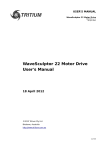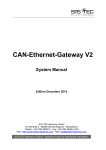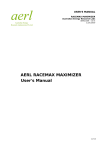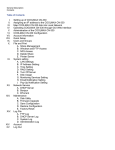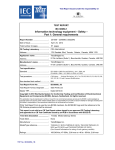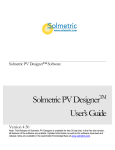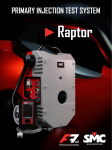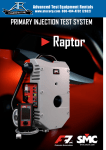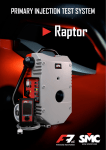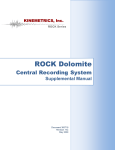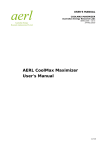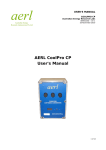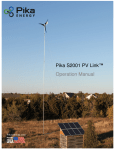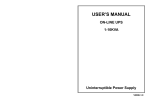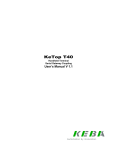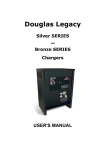Download COOLMAX SR G1 User Manual
Transcript
aerl USER'S MANUAL COOLMAX SR Australian Energy Research Laboratories AER07.004 – Version 3 th 15 October 2012 COOLMAX SR MAXIMIZER WALLMOUNT USER’S MANUAL aerl USER'S MANUAL COOLMAX SR Australian Energy Research Laboratories AER07.004 – Version 3 th 15 October 2012 TABLE OF CONTENTS 1 Overview ............................................................................................................ 3 2 Why use an MPPT? ........................................................................................... 3 3 Installation ......................................................................................................... 4 3.1 Mounting ....................................................................................................................... 4 4 Wiring................................................................................................................. 5 4.1 Signal Pin Assignment .................................................................................................. 6 5 Circuit Breakers ................................................................................................ 7 6 Earthing ............................................................................................................. 8 6.1 Connections ................................................................................................................. 8 7 LCD Display....................................................................................................... 9 7.1 7.2 LCD Symbols................................................................................................................ 9 LCD Fault Codes .......................................................................................................... 9 8 Can Communications ..................................................................................... 10 8.1 8.2 8.3 8.4 CAN Network Topology ............................................................................................... 10 CAN Wiring ..................................................................................................................11 Shielding......................................................................................................................11 CAN Termination..........................................................................................................11 9 Operating Guidelines...................................................................................... 12 9.1 9.2 9.3 9.4 9.5 Battery Charging Setup .............................................................................................. 12 Temperature Compensation........................................................................................ 12 Relay Alarm / Genset Control ..................................................................................... 13 Remote On/OFF Control ............................................................................................. 13 Maximizer Startup ....................................................................................................... 13 10 Adjusting The Charge Profile ........................................................................ 14 10.1 10.2 Charge Cycle Setpoints .............................................................................................. 14 Changing the Float Setpoint ....................................................................................... 14 11 PV Array Configuration Notes ....................................................................... 16 11.1 11.2 11.3 Optimal PV Array Configuration .................................................................................. 16 PV Input Blocking Diode ............................................................................................. 16 PV Module Power Rating and Mounting Considerations ............................................. 16 12 Troubleshooting .............................................................................................. 17 12.1 12.2 Low Battery Alarm Triggers Often ............................................................................... 17 Battery Bank Using Excessive Water (Electrolyte) ...................................................... 17 13 APPENDIX A – CAN Communications Protocol ........................................... 18 13.1 13.2 13.3 Overview .................................................................................................................... 18 Coolmax Broadcast Messages ................................................................................... 19 Coolmax Command Messages ................................................................................... 20 1 of 22 aerl USER'S MANUAL COOLMAX SR Australian Energy Research Laboratories AER07.004 – Version 3 th 15 October 2012 14 Warranty Information ...................................................................................... 21 15 Revision Record ............................................................................................. 21 16 NOTES ............................................................................................................. 22 2 of 22 aerl 1 USER'S MANUAL COOLMAX SR Australian Energy Research Laboratories AER07.004 – Version 3 th 15 October 2012 OVERVIEW The AERL Coolmax SR is a high efficiency, buck only, common positive Maximum Power Point TM Tracker (MPPT). It is the latest development in the Maximizer range, which was pioneered by AERL in 1985. The Coolmax SR blends the famously reliable AERL power stage with easy to use digital features such as system performance logging, fully configurable alarms and remote system monitoring and control. The Coolmax SR employs a maximum power point tracking strategy which has been proven to be highly robust, immune to local extrema, and results in power losses of less than 0.5% over the whole operating temperature range of a PV Array. Some of the device’s main features include: 2 Increase PV output by approximately 35% Super high conversion efficiency > 98% Built-in logging — 1 million sample points 12 months of daily statistics logged internally Common positive wiring configuration CAN bus interface High power density — 1kW/l & 1.5kW/kg Modular subrack mounting design is also available WHY USE AN MPPT? In simple terms, a Maximum Power Point Tracker sets the voltage of the solar panels to the ideal operating point of the panels. This is the maximum power voltage, or the voltage at which the solar cells can deliver maximum power to the load. This means that by using MPPT technology, the Coolmax can harvest up to 35% more energy from a solar array compared to a non-MPPT charge controller. The bottom line for solar system installers is that a cheaper, less powerful solar array can always be installed when using an MPPT – this saves cost, wiring and solar area. Because the MPPT can boost the panel’s output by up to 35%, the required array size and cost is reduced. The other benefit of MPPT converters is that a high voltage solar array can be converted down to a low voltage battery pack. This is advantageous because solar arrays are designed to be wired in series, and require much lighter wire when doing so. Additionally, a low voltage battery pack is intrinsically safer than a lethal, high voltage pack. 3 of 22 aerl 3 USER'S MANUAL COOLMAX SR Australian Energy Research Laboratories AER07.004 – Version 3 th 15 October 2012 INSTALLATION The Maximizer is designed to be installed in a clean dry location away from direct sunlight. Best cooling is achieved when the Maximizer is mounted vertically against a wall with a clear open area at the top of the unit. At least 20cm should be kept clear above the Maximizer to allow free air flow. 3.1 MOUNTING The maximizer should be fixed to a vertical surface using M5 screws through the 8 mounting holes in the chassis, shown as red holes in Figure 1. Figure 1 - Mounting Holes 4 of 22 aerl 4 USER'S MANUAL COOLMAX SR Australian Energy Research Laboratories AER07.004 – Version 3 th 15 October 2012 WIRING All Maximizer wiring must enter the unit via a 40mm conduit fitting at the bottom. Remove the access cover at the bottom of the Maximizer to install the cabling. This is done by removing the two M3 countersunk hex screws on the bottom of the enclosure at the front, as shown in Figure 2. Figure 2 - Removal of the Access Panel With the access cover removed, three terminal blocks should be visible. The left most terminal block is for the alarm output, remote shutdown input, and temperature compensation. The terminal block on the right is for the Controller Area Network (CAN). The central terminal block is for power in and power out. Figure 3 shows the pin-outs for these terminals. Figure 3 - Terminal Board Pinout (Looking into Access Port) 5 of 22 USER'S MANUAL aerl 4.1 COOLMAX SR Australian Energy Research Laboratories AER07.004 – Version 3 th 15 October 2012 SIGNAL PIN ASSIGNMENT Pin Assignment J1-1 GND J1-2 TMPCMP J1-3 GND J1-4 ON/OFF J1-5 Alarm NO J1-6 Alarm COM J2-1 PV IN- J2-2 PV IN+ J2-3 BATT OUT + J2-4 BATT OUT - J3-1 CAN +12V J3-2 CAN GND J3-3 SHIELD J3-4 CAN H J3-5 CAN L J3-6 NC Type Functional Description Isolated Analogue input Temperature compensation thermistor NO Digital input Pull these lines together to disable output of the Maximizer NO Clean contact output Will close when an alarm is active YES - 1000V PV PWR IN Refer to datasheet for the current and voltage limitations NO BATT PWR OUT Refer to datasheet for the current and voltage limitations NO Output power Power for the CAN bus YES Digital IO CAN signals YES Table 1 - Signal Pin Assignment 6 of 22 aerl 5 USER'S MANUAL COOLMAX SR Australian Energy Research Laboratories AER07.004 – Version 3 th 15 October 2012 CIRCUIT BREAKERS AERL recommends the use of 6kA, 8kA or 10kA DC rated circuit breakers with an appropriate voltage rating on both input and output. Double or triple ganged circuit-breakers can be connected in series to give the desired voltage rating as shown the example configurations of Figure 4. It is important that the peak voltages are taken into account when selecting breakers. For example a 120V nominal battery pack will be close to 150V at top of charge, so the breaking capability of the circuit breakers will need to be selected accordingly. It is important to note that the Maximizer attempts to process all available power from the PV array and therefore the output current from the Maximizer increases with decreasing output voltage. At a low enough output voltage the current will exceed the Maximizer’s over current trip point and will shutdown in order to protect itself. In the COOLMAX SR MV this trip point is 72A and in the COOLMAX SR HV it is 55A. This implies that a PV panel rated to produce the Maximizer's maximum battery charge current at nominal battery voltage will shutdown due to over current if the battery voltage falls below 1.7V per cell. The implication of the Maximizer behaviour described above is that an 80A rated circuit breaker should be used for the COOLMAX SR MV and a 63A rated breaker should be used for the COOLMAX SR HV. Figure 4 - Example breaker configuration for both the MV and HV COOLMAX SR assuming 60V rated DC breakers 7 of 22 aerl 6 USER'S MANUAL COOLMAX SR Australian Energy Research Laboratories AER07.004 – Version 3 th 15 October 2012 EARTHING NOTE: The chassis of the Maximizer should be earthed by installing an earthed ring terminal under the bottom left mounting bolt of the chassis. AERL recommends that the Maximizer be utilized in a floating system (no earthing to the power terminals) whenever possible. For very exposed systems, it is recommended that a lightning conductor be provided nearby to prevent damage to PV equipment, batteries and the Maximizer. For systems using Sunpower PV arrays, it is necessary to provide a positive earth for the array. DO NOT EARTH THE ARRAY in any way if a negative earth is used for the batteries or DC system. 6.1 CONNECTIONS Use appropriately rated wire to connect PV input and battery bank output. Check the polarity in the diagram provided in this user's manual. NOTE: Reversing polarity of either the input or the output will cause damage to the Maximizer. Install circuit breakers as described in Section 5 - Circuit Breakers. Check the polarity of the input and output with a multimeter before closing the breakers. 8 of 22 USER'S MANUAL aerl 7 COOLMAX SR Australian Energy Research Laboratories AER07.004 – Version 3 th 15 October 2012 LCD DISPLAY The LCD display cycles through four measurements, battery current, battery voltage, PV current, and PV voltage. Press the button to change which measurement is being displayed. 7.1 LCD SYMBOLS The display uses symbols to represent which measurement is being shown. The following table shows how to interpret the symbols. Measurement LCD symbols Battery current A, BAT Battery voltage V, BAT PV current A PV voltage V Table 2 - LCD Symbols 7.2 LCD FAULT CODES If the Coolmax detects a fault, it will display a code on the LCD display, as well as illuminating the 'HOLD' symbol. The fault codes are described in the following table. Faults can be reset by disconnecting the input and output of the Coolmax until the LCD display switches off. Fault Code Fault Description 1 Negative PV Current Current was detected flowing into the PV array. 2 High PV Current PV current high enough to damage Coolmax. 4 High PV Voltage PV voltage high enough to damage Coolmax. 8 High Battery Current Battery current high enough to damage Coolmax. 16 High Battery Voltage Battery voltage high enough to damage Coolmax. 32 High Temperature Heat−sink temperature high enough to damage Coolmax. 64 Fan Failure Fan has failed to start. Table 3 - LCD Fault Codes If multiple faults were detected by the Coolmax, the fault code displayed will be the sum of the fault codes of the individual faults. For example if high PV current and high battery voltage were detected together, the LCD display would show 18 (i.e. 2 + 16 = 18). 9 of 22 USER'S MANUAL aerl COOLMAX SR Australian Energy Research Laboratories AER07.004 – Version 3 th 15 October 2012 8 CAN COMMUNICATIONS 8.1 CAN NETWORK TOPOLOGY Multiple Coolmax units can exist on the same CAN bus and this can be connected to other networks using a CAN-Ethernet Bridge adaptor. The CAN bus is structured as a linear network, with short stubs branching from 'T' connectors on the main bus backbone to each device. The CAN bus data lines must be terminated at each end of the main bus with 120 Ω resistors between the CAN-H and CAN-L signals. A simple method of implementing the 'T' junction is shown in Figure 5. The in and out wire of each CAN line are twisted together and screwed into the appropriate terminal on the CAN connector, as shown in Figure 6. This connector plugs into J3 of Figure 3. Figure 5 - CAN Network Wiring Diagram Figure 6 - CAN Connector (6-Way Screw Terminal) 10 of 22 aerl 8.2 USER'S MANUAL COOLMAX SR Australian Energy Research Laboratories AER07.004 – Version 3 th 15 October 2012 CAN WIRING The CAN data lines (CAN-H and CAN-L) must be implemented with twisted-pair wire for proper data integrity. The wire should have a characteristic impedance of 120 Ω. Power should also be provided along the CAN cable, ideally with another twisted pair to minimise noise pickup. An overall shield can also be advantageous. The recommended choice of cable is 7mm DeviceNet CAN-Bus 'thin' cable, with 24 AWG (data) + 22 AWG (power) twisted pairs and a braided shield. Using this cable will result in a robust installation. Standard CAT5 network cabling (which has an impedance of 100 Ω) can be used, but may become unreliable in longer networks or in the presence of electrical noise from DC/DC converters and other electrical devices in the system. 8.3 SHIELDING Correct shielding practice is important for error free communications. Incorrect shielding can cause more interference than unshielded cables would experience. Shields should be linked between each wire segment along the network but only grounded in one place. The following paragraphs explain how to achieve this. The shield should be wired through the entire network independently of the ground and connected to ground at the end of the network and nowhere else in the network. This is shown at the right hand end of the example network in Figure 5. 8.4 CAN TERMINATION A 120 Ω resistor needs to be wired between the CAN-H and CAN-L lines at either end of the linear network in order to terminate both ends of the network. At the far end of the network the resistor can be simply installed into the last terminal block. If no CAN-Ethernet Bridge adapter is present on the network the same terminal block style termination can be made on the other end of the network. However, if a CAN-Ethernet Bridge adapter is present on the network, it can be used to terminate the network by wiring a termination resistor across CAN-H and CAN-L on the unused header. 11 of 22 USER'S MANUAL aerl COOLMAX SR Australian Energy Research Laboratories AER07.004 – Version 3 th 15 October 2012 9 OPERATING GUIDELINES 9.1 BATTERY CHARGING SETUP The batteries are charged using an automatic equalise / anti-sulphation charging profile. This profile is designed for lead-acid batteries, which can be equalised automatically by allowing each battery to vent for a short time. The charge profile can be edited for other battery chemistries by manipulating the following parameters Bulk voltage Float voltage Bulk reset voltage Bulk time Battery chemistries other than lead acid should be used with extreme caution as it is not safe to overcharge individual cells. It is always recommended to employ a battery monitoring system as an unbalanced battery pack can result in damage to batteries due to overcharging. An example charge profile for the Coolmax SR is shown below to illustrate the charge profile parameters above. To edit the charge profile parameters, please refer to the documentation for the Coolmax SR communications software. Figure 7 - Battery Charge Control Profile 9.2 TEMPERATURE COMPENSATION Temperature compensation measures the temperature of the batteries and adjusts the float voltage set point to the ideal voltage for batteries at that temperature. The thermistor is connected between J1-1 and J1-2 as shown in Figure 3. The Coolmax SR measures the voltage between TMPCMP+ and GND to determine the temperature of the batteries. Using the temperature of the batteries, the Coolmax SR adjusts the float voltage by a user specified factor in millivolts per C. NOTE: The temperature compensation factor is adjusted using the Coolmax SR software. Please refer to its documentation for more information. 12 of 22 aerl 9.3 USER'S MANUAL COOLMAX SR Australian Energy Research Laboratories AER07.004 – Version 3 th 15 October 2012 RELAY ALARM / GENSET CONTROL The ALARM pins are the contacts of an isolated 12V, 1A relay. When an alarm state is in effect, ALARM will be connected inside the Maximizer. When the alarm state is removed, ALARM will be completely disconnected from each other. An external alarm or Genset control circuit can be used to sense whether ALARM is open or closed. Many different events can be attached to the relay. These are: System init (system starts up after a reset or off period) Low output voltage warning Low output voltage fault Low output voltage Genset start High output voltage fault High output current fault High discharge current fault Input breaker open Output breaker open Temperature sensor fault Regulation fault Log file full Panel missing These are configurable so that multiple faults could trigger the relay. There is also a time hysteresis which prevents the relay from triggering on spurious readings. To configure the events, consult the documentation for the Coolmax SR software. 9.4 REMOTE ON/OFF CONTROL The remote ON/OFF control can be implemented with a single switch connected between the ONOFF pin and GND pin. The Coolmax SR will sense if the ONOFF pin has been connected to GND when the switch closes and this will disable the Maximizer. 9.5 MAXIMIZER STARTUP The Maximizer electronics will begin to run when either the input or output is connected with a voltage above the start-up voltage listed in the datasheet. CAN communications can be used whenever the Maximizer is powered up. 13 of 22 aerl USER'S MANUAL COOLMAX SR Australian Energy Research Laboratories 10 ADJUSTING THE CHARGE PROFILE 10.1 CHARGE CYCLE SETPOINTS AER07.004 – Version 3 th 15 October 2012 The CoolMax SR uses a 2 stage bulk / float charge cycle. Only the float point can be set using the LCD display, but the bulk voltage set−point is automatically set to 108% of the float set−point. Any other parameters of the charge cycle, such as the bulk reset voltage, are automatically calculated. Note: If the bulk set−point needs to be chosen independently of the float set−point, PC software will need to be used with a CAN-Ethernet Bridge adaptor to communicate with the CoolMax. 10.2 1. CHANGING THE FLOAT SETPOINT Press and hold the button for 5 seconds until the screen changes. This is the float set mode. It will display the currently set float voltage in the Maximizer. NOTE: If you have just changed the float voltage in the CoolMax SR software using a CANEthernet bridge, you may see a different float voltage than you expect. You will need to reset the device before your original change will take effect. BAT flashes the whole time when editing the battery float voltage. Edit Hundred’s column first The HUNDREDS column can now be edited. Press the button to toggle between a 1 and a 0 in the hundreds column. 2. Press and hold the button for about 2 seconds until the TENS column starts to flash. TEN’S Column flashes when editing The TENS column can now be edited. Repeatedly push the button to change the value of the digit. The value rolls over from 9 back to 0 if you accidentally overshoot. 3. Once you have the correct digit, press and hold the button for about 2 seconds until the ONES column starts to flash. ONE’S Column flashes when editing The ONES column can be edited when that digit is flashing. Repeatedly push the button to change the value of the digit. The value rolls over from 9 back to 0 if you accidentally overshoot. 14 of 22 aerl 4. USER'S MANUAL COOLMAX SR Australian Energy Research Laboratories AER07.004 – Version 3 th 15 October 2012 Once you have the correct digit, press and hold the button for about 2 seconds until the TENTHS column starts to flash. TENTH’S Column flashes when editing The TENTHS column can be edited when that digit is flashing. Repeatedly push the button to change the value of the digit. The value rolls over from 9 back to 0 if you accidentally overshoot. 5. If you need to change any digit, press and hold the button for 2 seconds, the TENTHS column will stop flashing, and you will be editing the HUNDREDS column again. Otherwise, if you are happy with the float voltage that you have input, press and hold the button for 5 seconds. 6. The display will change to all dashes and will flash. This means that the changes are taking effect. Wait 30 seconds to a minute. All flashing dashes – “Please Wait” while the new float voltage is committed to memory. After about 30-60 seconds, the display will reappear with the new float voltage that you have set. This will be flashing so that you can confirm that it is correct. 7. Press the button again to take the CoolMax SR back to normal operation. 15 of 22 aerl USER'S MANUAL COOLMAX SR Australian Energy Research Laboratories 11 PV ARRAY CONFIGURATION NOTES 11.1 OPTIMAL PV ARRAY CONFIGURATION 11.2 AER07.004 – Version 3 th 15 October 2012 The minimum Vmp of the array must be greater than the battery bulk charge point. The closer the nominal Vmp of the array is the nominal battery voltage the more efficient the maximizer. The input open circuit voltage (Voc) must be above the minimum voltage listed in the datasheet for the Maximizer to run. PV INPUT BLOCKING DIODE A PV Input blocking diode should not be used as long as the open circuit voltage of the PV array is within the range specified by the datasheet for the appropriate Maximizer model and battery voltage. The idea of the blocking diode is to prevent night time reverse leakage from the battery into the PV array. However the diode introduces power wastage during operation which outweighs the leakage, resulting in a net power loss. 11.3 PV MODULE POWER RATING AND MOUNTING CONSIDERATIONS The nominal power output rating of a particular PV Module is specified by the PV Module Manufacturer, at One Sun (1000W/sq.m of sunlight radiation) and 25C. PV Module Maximum Power Voltage (and consequently maximum power) falls off by 4% per every 10C that the PV panel rises above this 25C specification, so typical panel temperatures on a hot summers day of 65C will result in a panel power derating of 16% of the manufacturers rating. It is best to mount the PV Array in a way that the hot air behind the panels can easily escape via the natural breezes or convection. So don’t mount the PV Array flat against the roof surface, but ensure there is at least 40mm spacing below the panels. Small gaps (20-30mm) left between adjacent panels are also a good idea to let out the hot air from the sides. NOTE: Around 80% of the sun-light energy falling on the solar cells is converted directly into heat, not electricity, and heat is the power output enemy of PV modules. 16 of 22 aerl USER'S MANUAL COOLMAX SR Australian Energy Research Laboratories 12 TROUBLESHOOTING 12.1 LOW BATTERY ALARM TRIGGERS OFTEN AER07.004 – Version 3 th 15 October 2012 This could indicate that the PV system is underpowered, never reaching a full 108% equalise value. The battery life will be severely compromised in this situation. The more often the alarm comes on, the more power should be added to the PV array. Solution: Add more PV modules to the array to increase the power output. If the array is sufficiently powerful, but the alarm is still very often on, check that the Maximizer is set up for the correct voltage of the battery pack. See the Coolmax SR software user’s manual for adjusting the battery float voltage. Also check that the Maximizer is charging the battery by checking the output current on the LCD meter, and if the Maximizer is not functioning contact technical support. 12.2 BATTERY BANK USING EXCESSIVE WATER (ELECTROLYTE) The battery bank is lightly loaded compared to the input PV power and rarely comes off float voltage. Adjust the float voltage down by a few volts using the Coolmax SR software. 17 of 22 USER'S MANUAL aerl COOLMAX SR Australian Energy Research Laboratories AER07.004 – Version 3 th 15 October 2012 13 APPENDIX A – CAN COMMUNICATIONS PROTOCOL 13.1 OVERVIEW 13.1.1 Hardware The CAN hardware interface used is compatible with the CAN 2.0B standard. The supported bit rates (bits per second) are 1 Mbps, 500 kbps (default), 250 kbps, 125 kbps, 100 kbps and 50 kbps. 13.1.2 Software The CAN protocol uses data frames for most communication. Remote frames are also enabled. All measurement data is transmitted using IEEE single-precision 32-bit format (IEEE 754) with most significant byte (MSB) sent first. Bit Length 1 11 6 8 Bytes 16 2 7 Start Identifier Control Data Field CRC Ack End Figure 8 - CAN Data Frame 13.1.3 Identifier The identifier field has been split into two sections for the Coolmax SR. Bits 10-5 contain the device identifier and bits 4-0 contains the message identifier associated with that device, as shown below. 10 5 4 0 DEVICE IDENTIFIER MESSAGE IDENTIFIER Figure 9 - CAN Device Identifier Address Format 13.1.4 Data Field The data field in all frames is fixed at 8 bytes (64 bits) which allows space for two IEEE 754 32-bit floating point variables as shown in the figure below. The data field is sent and expected to be received least significant byte first. This allows a direct overlay of a float[2] array and char[8] array on a little endian processor. High float Low float s eeeeeeee mmmmmmmmmmmmmmmmmmmmmm s eeeeeeee mmmmmmmmmmmmmmmmmmmmmm ^ ^ ^ ^ 63 62 ^^ 55 54 ^ 32 31 30 ^^ ^ 23 22 0 Figure 10 - Format of a Data Field in a Data Frame 18 of 22 USER'S MANUAL aerl 13.2 COOLMAX SR Australian Energy Research Laboratories AER07.004 – Version 3 th 15 October 2012 COOLMAX BROADCAST MESSAGES Data frames containing telemetry values are periodically broadcast onto the bus by the Coolmax. 13.2.1 Identification Information ID: Coolmax Base Address + 0 Variable 13.2.2 Uint32 Device serial number, allocated at manufacture. Product ID 31…0 Uint32 “A001” stored as a string. PV Voltage/Current Measurement Coolmax Base Address + 1 Bits Type Description PV Current 63…32 float PV Current PV Voltage 31…0 float PV Voltage Output Voltage/Current Measurement ID: Coolmax Base Address + 2 Variable Bits Type Description Output Current 63…32 float Output Current Output Voltage 31…0 float Output Voltage PV Open Circuit Voltage/Output Charge Measurement ID: Coolmax Base Address + 3 Variable 13.2.5 Description 63…32 Variable 13.2.4 Type Serial Number ID: 13.2.3 Bits Bits Type Description Output charge 63…32 float Output charge PV OC Voltage 31…0 float PV OC Voltage PV Power/Battery Temperature Measurement ID: Coolmax Base Address + 4 Variable Bits Type Description Battery Temperature 63…32 float Battery Temperature PV Power 31…0 float PV Power 19 of 22 USER'S MANUAL aerl 13.2.6 AER07.004 – Version 3 th 15 October 2012 Active Flags ID: Coolmax Base Address + 5 Variable Bits Type 63…13 - Panel missing 12 Boolean Input voltage indicates panel missing Log file full 11 Boolean Log file full Maximizer fault 10 Boolean Regulation or power stage fault Bat temp sensor fault 9 Boolean Battery temperature sensor fault Not used 8 Boolean - Not used 7 Boolean - Hi bat temp 6 Boolean High battery temp fault Bat current 5 Boolean High battery discharge current fault Iout fault 4 Boolean High output current fault Vout high fault 3 Boolean High output voltage fault Not used 2 - Vout low fault 1 Boolean Low output voltage fault Vout low warning 0 Boolean Low output voltage warning Unused 13.2.7 COOLMAX SR Australian Energy Research Laboratories Description - - Time ID: Coolmax Base Address + 7 Variable Bits Type Time 63…0 Uint64 13.3 COOLMAX COMMAND MESSAGES 13.3.1 Reset Command ID: Description System Unix time Driver Controls Base Address + 23 Variable Bits Units Description Unused 63…32 Unit32 - Reset command string 31…0 Uint32 Send 'ALL' or 'RCO' as a string (“00000ALL”) ALL – full reset Coolmax replies with Y or N in byte 0 RCO – remote config reset 20 of 22 USER'S MANUAL aerl 14 15 COOLMAX SR Australian Energy Research Laboratories AER07.004 – Version 3 th 15 October 2012 WARRANTY INFORMATION 1. AERL warrants that the Product will be free from manufacturing defects for a period of 24 months from the date of dispatch of the products by AERL to the customer. 2. The Products technical specifications are contained within the Product Datasheet. The Product will conform to the technical specifications contained in the Product Datasheet at the time of dispatch of the Products to the Customer. If the technical specifications as contained in the Product Datasheet are not met, AERL will repair, replace the Product, or refund the amount paid by the Customer in relation to the Product at the Customers option. AERL is under no obligation to provide assistance or advice to the Customer in relation to the technical specifications. 3. The Products must be installed in strict accordance with the Installation Recommendations listed in this Manual. 4. In no event will AERL be liable for: a) any loss or damage which the Customer suffers arising from, or caused or contributed to by, the Customer's negligence or the negligence of the Customer's agents or servants; and b) special, indirect or consequential loss or damage as a result of a breach by the Customer of these Standard Terms including, without limitation, loss of profits or revenue, personal injury, death, property damage and the costs of any substitute Products which the Customer obtains. 5. The Product is not covered for damage occurring due to water, including but not limited to condensation, moisture damage and other forms of precipitation. 6. The Product is not covered for damage occurring due to the Product being incorrectly installed or installed in a manner not in accordance with the Installation Recommendations listed in the Product Manual. 7. The Product is not covered for damage occurring due to failure on the part of the customer to operate the product in accordance with the technical specifications as listed in the Product Datasheet. 8. The Product is not covered for damage occurring due to lightning. 9. The Product is not covered for situations where it is used in a manner not specifically outlined in the Product Manual. 10. If any provision in this document is invalid or unenforceable this document will remain otherwise in full force apart from such provision, which will be deemed deleted. REVISION RECORD REV DATE CHANGE 1 05/07/2011 Document creation (DAF) 2 05/09/2012 Converted from Open Office document to Word 2007 document. Made formatting changes. Added the correct use of styles. 3 15/10/2012 Added section for Adjusting the Charge Profile. Added new image for Pin−outs. Table 4 - Revision Record 21 of 22 aerl 16 USER'S MANUAL COOLMAX SR Australian Energy Research Laboratories AER07.004 – Version 3 th 15 October 2012 NOTES 22 of 22























